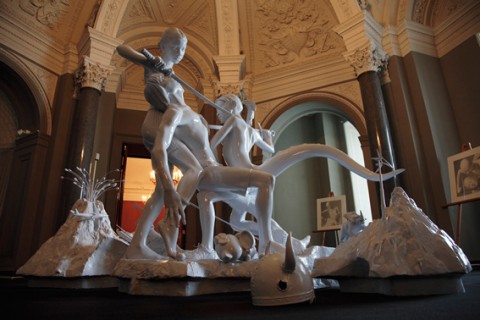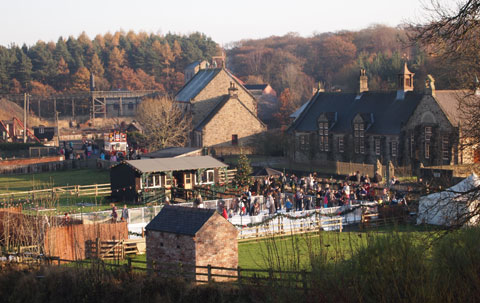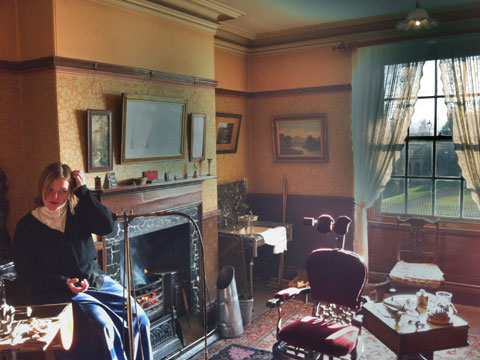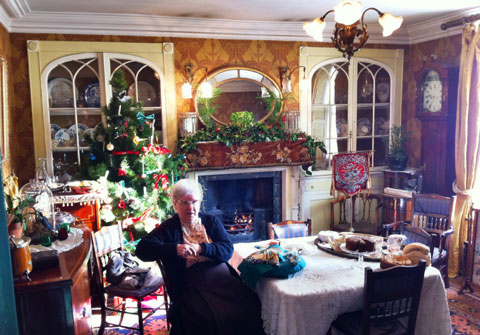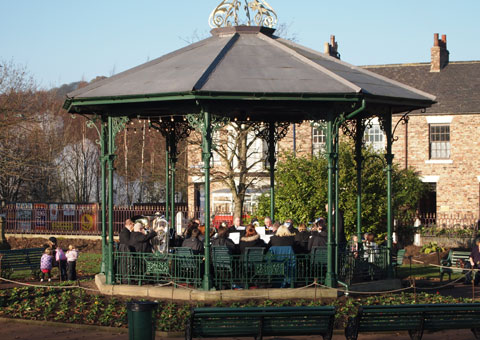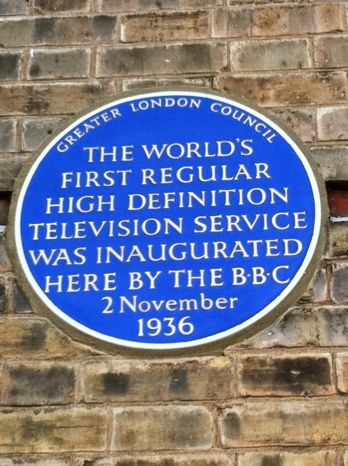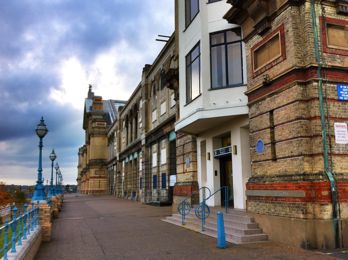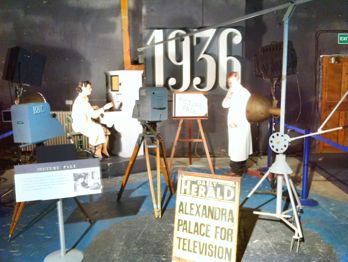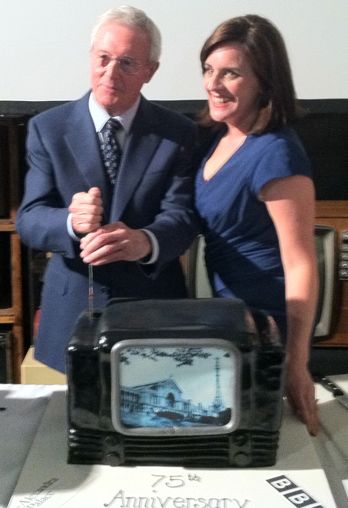Category — History
Last Riot at Valle dei Templi
Situated near the SW Sicilian coast is the town of Agrigento, home of the so-called “Valley of the Temples” (Valle dei Templi), a ridge of land above the ancient city that is the site of a linear cluster of (mainly) Ancient Greek ruins, many of which are quite spectacular — the place is well worth a visit. It is a UNESCO World Heritage site.
In addition to the Greek and Byzantine remains, there is the Villa Aurea, which was home to 19th Century British military officer and archaeological patron Alexander Hardcastle, who financed, among other things, the re-erection of the pillars at the Temple of Heracles on the site.
Today, the Valle dei Templi is not simply a collection of ancient sites: it’s also a location for modern art which is distributed among the ruins and elsewhere, such as in the Villa.
Thus it was that on a recent visit I encountered this remarkable piece of statuary in the Villa Aurea garden, in brilliant, shiny white material showing a group of fashionably-dressed young people poised to kill one of their number with various weapons. What on Earth was this amazing piece of work? There was no indication on or near the piece to indicate its origin or significance.
After a surprisingly lengthy Internet search, I found the answer. It is a (small) part of a multimedia collection of works by the Moscow-based art group “AES+F” titled Last Riot/Last Riot 2.
AES+F are named after their initials: the group, founded in 1987, was originally AES — Tatiana Arzamasova, Lev Evzovich and Evgeny Svyatsky — but they were later joined by photographer Vladimir Fridkes — hence the “+F”.
Last Riot first appeared in 2007 at the Venice Biennial as a three-screen video providing windows into a highly detailed 3D virtual environment, inspired apparently by the US Army video game “America’s Army”, created to encourage young people to enlist. You can see excerpts from it here:
AES+F say about the work:
“The virtual world generated by the real world of the past twentieth century as the organism coming from a test-tube, expands, leaving its borders and grasping new zones, absorbs its founders and mutates in something absolutely new. In this new world the real wars look like a game on www.americasarmy.com, and prison tortures appear sadistic exercises of modern valkyrias. Technologies and materials transform the artificial environment and techniques into a fantasy landscape of the new epos. This paradise also is a mutated world with frozen time where all past epoch the neighbor with the future, where inhabitants lose their sex, and become closer to angels. The world, where any most severe, vague or erotic imagination is natural in the fake unsteady 3D perspective. The heroes of new epos have only one identity, the identity of the rebel of last riot. The last riot, where all are fighting against all and against themselves, where no difference exists any more between victim and aggressor, male and female. This world celebrates the end of ideology, history and ethic.”
In addition to the video, there are series of glossy white sculptures of which the example at the Villa is one, and remarkable still images featuring the same weaponised, brand-name-dressed young people, in a kind of superrealistic style that somehow echoes works of the Renaissance as much as they do CGI-created videogame characters.
Here’s the statue from the Villa in an art gallery setting (from the AES+F web site):
…and one of the images from the same source:

I would love to experience the original video as well as the other pieces, especially given my interest in virtual worlds. Kudos to the people who arrange the art exhibitions along the Valle dei Templi for introducing me — and many other people I hope — to the stunning work of a fascinating group of artists.
Visit the AES/AES+F web site
Last Riot on the AES+F web site
April 20, 2012 Comments Off on Last Riot at Valle dei Templi
Christmas(ish) At Beamish
Whenever I’m in the NE of England, I try to get over to Beamish - “The Living Museum of the North”. It’s a wonderful place built around a road/tramway loop on which run vintage buses and trams.
On this occasion (20 November) I was up for the weekend to go to Lumiere in Durham, so nipping over was a chance I couldn’t miss. It was foggy on leaving Durham but approaching Beamish the sun came out and it was gorgeously sunny until the drive home, when the fog closed in again.
Different sites around the tramway loop recreate different eras, each created from buildings that have been lovingly transplanted from their original sites: the Town, for example, is Edwardian, with a Bank, a gorgeous Masonic Hall (rebuilt with the help of the Masons, apparently), a Co-Op department store, sweet shop/factory and lots more. It also has an adjacent Steam Railway and station and a steam-powered fairground.
The Pit Village is perhaps somewhat earlier, and features a colliery and a relatively new addition: a coal-fired fish & chip shop that uses beef dripping to cook with, resulting in utterly tasty meals that you have to queue for twenty minutes or so to get, it’s so popular. Yet another area, Pockerley, is more Georgian, with a Waggonway that features steam locos from the earliest times and Pockerley Old Hall. I’ve talked about Beamish before, here.
From this time of year until Christmas itself, Beamish is having a series of Christmas weekends, including Santa’s Grotto somewhere over by Pockerley I think, complete with snow, an ice-rink in the Colliery Village (above), and decorations up in the Town.
I had to pop into some of the terraced houses, several of which contain businesses, such as a solicitor’s and a dentist — the torture chamber itself is shown below. In those days you would have had the option of (unregulated) nitrous oxide (with a fair risk of death) or cocaine as anaesthetics, the latter effectively removing your short-term memory, so things hurt but you didn’t remember it (rather like intravenous Valium it would appear, which I always loved as an adjunct to dental operations).
Another house included period Christmas decorations in the front room.
Across the street is a little park, with a bandstand, and there was the Murton Colliery Band preparing to play some suitably seasonal music, which they proceeded to do beautifully.
Here’s some video of extracts from their programme:
The band was formed as the Murton Gospel Temperance Blue Ribbon Army Band in 1884, and players were requested to wear a blue ribbon on the second button of their waistcoats. They became Murton Colliery band in 1895. When the colliery closed, the band became self-supporting — and it still is today. They’re also one of the few remaining bands to continue to call itself a ‘Colliery Band’, and they still proudly march through the village during the Durham Miners Gala and Armistice Day. I don’t know about you, but brass band music and Christmas do seem to go together rather well.
 There was time for a good wander around and trips on some of the trams — including a 1930s enclosed double-decker Blackpool tram, which is technically a little late for their re-creations but very impressive — and I had some good chats with the tramway staff, noticing that they wore the archetypal “wheel and magnet” emblem of British Electric Traction (later to become the parent, surprisingly, of Rediffusion Television) on their caps. The shop at Beamish should sell those cap badges — I would have bought at least one.
There was time for a good wander around and trips on some of the trams — including a 1930s enclosed double-decker Blackpool tram, which is technically a little late for their re-creations but very impressive — and I had some good chats with the tramway staff, noticing that they wore the archetypal “wheel and magnet” emblem of British Electric Traction (later to become the parent, surprisingly, of Rediffusion Television) on their caps. The shop at Beamish should sell those cap badges — I would have bought at least one.
Finally it was time to head off on the 3+ hour home, and soon after getting back on the A1 the fog closed in, and it ended up taking a good deal longer than that. But it was a great day out.
November 23, 2011 Comments Off on Christmas(ish) At Beamish
75 Years of BBC Television
Wednesday 2nd November saw the 75th anniversary of the opening of the BBC Television Service.
To commemorate the event, the BBC held a special celebration at Alexandra Palace, where the Service opened.
Originally, the intention was to hold a special Open Day on the 2nd, at which members of the public would be able to visit the studios and see audio-visual presentations. However this was eventually moved to November 5–6, leaving only an internal BBC event happening on the actual day.
I managed to obtain an invitation, for which my thanks to the ebullient Robert Seatter, head of BBC History, and technology journalist Bill Thompson.
The invitation said “3:45 for 4pm” and as a result I found myself in the Alexandra Palace Tower end car park well in time for the off, giving some time to take in the views over the city, experience the continual wind and enjoy some dramatic skies over this “Palace of the People” located at the highest point in North London.
When the BBC decided on Ally Pally as the site for the new BBC Television Service in the wake of the Selsdon Report in 1936, the place was already decaying somewhat. It’s a process that has continued since BBC Television left here several decades ago, and although the team now fronting the Trust that runs the site today is incredibly, and impressively, enthusiastic and upbeat, there is no way it can be other than an uphill struggle in these austere times. But you can’t say they aren’t trying hard and I wish them every success.
The BBC still maintains active offices in the block under the mast. But instead of entering through the doors there, adjacent to the GLC blue commemorative plaque on the wall, we were motioned into an entrance along to the left, up a metal ramp and into what had originally been the Transmitter Hall. It may be noted that this was probably not the first, but possibly the last, time that anyone had the bright idea of placing a pair of powerful VHF transmitters and a pigging great set of transmitting antennae right next to a set of television studios full of sensitive equipment.
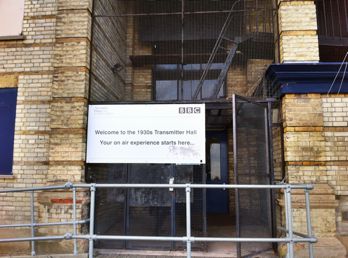 Inside, the room had been decorated with panels against the walls, each carrying information and images of some aspect of Ally Pally TV history, and a free-standing photo display of historical images, mainly provided by the Alexandra Palace Television Society. A jazz quartet played suitable 1930s style music; servers glided among the assembled invitees dispensing water, orange juice or Prosecco.
Inside, the room had been decorated with panels against the walls, each carrying information and images of some aspect of Ally Pally TV history, and a free-standing photo display of historical images, mainly provided by the Alexandra Palace Television Society. A jazz quartet played suitable 1930s style music; servers glided among the assembled invitees dispensing water, orange juice or Prosecco.
We had the chance to mingle and chat, and I was very pleased to meet TV cook Zena Skinner, who probably coined the phrase “Here’s one I made earlier” — though in her case she really had made it earlier, herself; I also met Professor Jean Seaton, the BBC’s Official Historian and Professor of Media History at the University of Westminster; and talked briefly to John Trenouth, Technology Adviser to the BBC Collection, whom I met during his time at what is now the National Media Museum in Bradford.
In the centre of the room, a make-up table and lights were set up, where various young women were being made up using the colours required by the Baird System.
When the BBC Television Service was established, the Government required two television systems to be used. On the one hand was the all-electronic Marconi-EMI system, which offered 405 lines, and on the other was the Baird electromechanical system which delivered 240-line television. Early on, it became evident that the Marconi-EMI system was significantly superior, but it had been Baird who had tirelessly promoted television as a concept, and lobbied the GPO over licensing and the Government to legislate for a Television Service. Baird highlighted the fact that his was a British invention – though it could equally legitimately be claimed that the Marconi-EMI system was British. Almost certainly the Government decision, a typical British compromise, was made at least in part to avoid suggestions that they were turning down a British innovation, the decision mandating the use of both systems on an alternating basis for six months before a choice was to be made before the two. The problems experienced with the technological dead-end of the Baird mechanical scanning system resulted in the decision — in favour of Marconi-EMI — to be made after just three months.
Baird Television actually used two systems. The fundamental feature of both was a “flying spot scanner” in which, almost completely counter-intuitively, the scene was scanned with a spot of light and photocells collected the light reflected from the subject. The “Spotlight Studio” used nothing more than this; the Intermediate Film Technique used a conventional film camera, exposed film from which was then passed immediately through developer and highly poisonous cyanide-based fixer (particularly nasty when it got loose), then scanned with a a flying spot actually under water. The flying spot scanner was very sensitive to red light, so if you were appearing in the Spotlight Studio, you needed the special make up: black lipstick, blue eye-shadow and a pale white face. Very neo-Goth. You checked it by looking through a red gel.
This was the make-up that was being applied to the young ladies at Ally Pally on the 2nd. Apparently the idea had originally been that BBC London would be sending a crew up to cover the party, but they had pulled out and the job was left to an enthusiastic team from BBC News School Report.
Meanwhile, we were treated to welcoming presentations: by the PR gentleman from the AP team, and from Robert Seatter, who encouraged us to relinquish our glasses and proceed upstairs to Studio A.
There were two main studios at Ally Pally originally, one above the other. Studio A was the Marconi-EMI studio, while directly above it was the Baird studio, Studio B. You can’t go into B today, because it’s riddled with asbestos and things are likely to fall on your head. But Studio A is accessible. At one end of the room is a tableau representing the production of the magazine programme Picture Page, which ran from 1936–39 and 1946–52 and was initially presented by Joan Miller.
Around the room are assembled old TV sets, and various exhibits in the room itself included an EMItron camera, which John Trenouth of the National Media Museum in Bradford kindly removed the lid of so we could have a look at the innards (sans tube).
In Studio A we were treated to a couple of brief audio-visual presentations, the first assembled mainly from clips from the film documentary Television Comes To London, which was made to tell the BBC Television Service story in 1936. Rebecca Kane, the MD of Alexandra Palace Trading Ltd, introduced Michael Aspel, a newsreader at AP during the period when BBC Television News was based here, to cut the cake.
And what a cake it was: made in the form of an old bakelite television with a picture of Alexandra Palace on the screen, deliciously thick icing and succulent innards. Very nice.
After that, we all wandered around Studio A and chatted to each other. I got into an amusing discussion about the way in which the Television Service closed down at the start of the Second World War, on September 1st, 1939 – about which a number of myths have arisen, most of which are incorrect (including the perpetuation of the main myth in Alan Yentob’s Imagine documentary, re-shown on Wednesday) – see The Edit that Rewrote History on the Transdiffusion Baird site, which includes a number of articles on television prior to 1955.
And then we gradually sloped off home.
See also:
The birth of television: the “Baird” microsite at Transdiffusion
75 years on from BBC television’s technology battle — a nice piece by John Trenouth
BBC Celebrates 75 Years of TV — Nick Higham visits Alexandra Palace
November 5, 2011 Comments Off on 75 Years of BBC Television
& Simpson">“Only Remembered” — Coope Boyes & Simpson
In this video, leading British folk musicians Coope Boyes & Simpson provide the music in their unique and moving acapella style with the song “Only Remembered”, as we view aspects of the unique exhibition by the University of Oxford’s First World War Poetry Digital Archive in the immersive 3D virtual world of Second Life.
The exhibition simulates aspects of life in the trenches on the Western Front during the 1914–1918 war and presents work by the “War Poets” of the period.
As visitors explore the simulation, they can listen to the voices of veterans recounting their experiences of the war, view original film footage and photographs from the time, and learn about life on the Western Front, encountering some of the most powerful poetry in English literature by seeing the original manuscripts, turning the pages of the poets’ war diaries and letters, and listening to readings.
The video is taken from the 10 November 2009 episode of the TV series Designing Worlds, a weekly live show covering design and designers in virtual worlds, produced by Prim Perfect magazine and Treet.TV.
“Only Remembered” (Bonar/Sankey/Tams Voice Publishing) is used by permission and is taken from the album Private Peaceful The Concert (No Masters NMCD24) by Coope Boyes & Simpson.
For more information, read this article on The First World War Poetry Digital Archive in Second Life.
November 14, 2009 Comments Off on “Only Remembered” — Coope Boyes & Simpson
Oxford University’s virtual First World War site opens in Second Life
I’d like to draw your attention to the following press release regarding the opening of the Second Life presence of Oxford University’s First World War Poetry Digital Archive. I was involved in recording some of the audio for this project, including several poetry readings, tutorials and the introduction and epilogue to the installation. More details here; video at foot of this article.
An exciting new project in interactive education will launch on 2nd November 2009, drawing together the resources and expertise of the University of Oxford, and the possibilities for immersion and interactivity offered by the virtual world of Second Life.
The First World War Poetry Digital Archive and the Learning Technologies Group at the University of Oxford have collaborated to bring together a wealth of digitised archival material from the First World War into an environment that allows this powerful material to be explored and experienced in a radically new way.
“The aim of the initiative is to place the poetry of the Great War in context,” explains Stuart Lee, Lecturer in English at the University of Oxford, “It allows the visitors to the exhibition to visualise archival materials in an environment that fosters deeper understandings. Visitors also have the opportunity to take advantage of the social and interactive aspects that the environment offers.”
The project has imported into the Second Life environment a range of digitised archival materials from the major poets of the First World War (including poetry manuscripts, letters and diaries) along with contextual primary source materials. These have been positioned within an environment which has been modelled to represent areas of the Western Front, 1914 — 1918.
The materials have been supplemented with new interpretative content and a spectrum of interactive tools and tutorials, streaming video and audio effects to create a vivid immersive experience that is, according to visitors, deeply moving.
“I had, of course, read about the First World War, and seen archive news footage too,” says Saffia Widdershins, a Second Life resident. “But to have the feeling of walking along narrow trenches on duckboards half covered in mud, to see the dugouts, or to stand in a dressing station, hearing the voices of people who had been there describing their own experiences – this is all incredibly powerful.”
There will be a Second Life Press Launch at 4.30am SLT (12.30 UK time) and again at 2pm SLT (22:00 UK time) on Monday 2nd November. Come to the landing point at: http://slurl.com/secondlife/Frideswide/219/199/646/ and take the TP to Theatre.
The installation will be open for exploration from 2am Monday 2nd November 2009. We ask visitors to preserve the atmosphere of this environment by wearing the clothing provided at the landing area.
November 1, 2009 Comments Off on Oxford University’s virtual First World War site opens in Second Life
“…And each slow dusk a drawing down of blinds.”
As readers may know, one of my several activities is audio production, both voice-over work and the production of complete packages with voice, music, effects and so on.
Recently many of these productions have been particularly associated with educational programmes, clients including the British Library and City of Sunderland College. Interestingly, all these projects have resulted from meeting people in the virtual world of Second Life. (Partially as a result, incidentally, I do not have a great deal of time for people who criticise me for “playing” in SL or try to convince me that nothing significant will come of it.)
I have a teaching qualification myself, and I’m particularly interested in the educational possibilities of virtual worlds: Second Life is by far the most popular and widely-used of the virtual worlds currently available, although there is increasing activity in “OpenSim” variants using essentially the same technology.
Most recently I was introduced to some of the staff of the First World War Poetry Digital Archive, based at the University of Oxford. They are on the point of launching (on 2 November) a new region in Second Life (named Frideswide after the patron saint of Oxford) which is home to a painstakingly-built environment designed to shed light on aspects of the life of soldiers in the trenches along the Western Front during the First World War. Students can visit the site and learn not only about the conditions endured by infantrymen during the Great War but also hear poetry from the ‘War Poets’, along with interviews and tutorials.
Here’s how they describe the installation:
This tour of a stylised version of the trench systems in the Western Front has … two objectives:
• to show you the physical context of the trench systems
• to expose items held in the First World War Poetry Digital Archive in a three-dimensional environment…This [is] not an attempt to give you a realistic experience of what it was like to be on the Western Front. The physical depravation, or the chance of serious injury or death, cannot be replicated, and this should always be remembered.
More importantly perhaps, this is but one view of the War – and it would be safe to say this is a view open to discussion. …we have presented rain-sodden trenches, infested by rats, in gloomy surroundings. But this was not always the case. The opening day of the Battle of the Somme, for example, was a beautiful summer’s morning in stark contrast to the depictions we often see of the muddy hell of Paaschendaele.
Chris Stephens, who has been instrumental in putting the simulation together, commissioned me initially to provide an audio version of an A‑level/University-level Tutorial on “Remembrance” along with four poems: Anthem for Doomed Youth by Wilfred Owen, Does It Matter? by Siegfried Sassoon, plus Louse Hunting and Dead Man’s Dump by Isaac Rosenberg.
I’ve now recorded some additional poetry readings – Repression of War Experience, Aftermath, and On Passing the New Menin Gate, all by Siegfried Sassoon; plus 1916 Seen From 1921 and Can You Remember by Edmund Blunden – and an introduction and epilogue.
These poems have a great deal to tell us about the feelings of their authors, and many of them are powerfully moving. Dead Man’s Dump in particular is full of vivid, detailed imagery.
The tutorial, on the other hand, encourages us to ask a number of questions about our conception of what the Great War was like, and uncovers where much of our information has come from. It also challenges some of our assumptions about the conflict. At the time of writing, there are only three veterans of the First World War left alive, so we rely increasingly on indirect sources.
In the Second Life representation, you start off at an army camp and then proceed to the trenches via a floating bubble, during which you hear the introduction to the installation.
Once at ground level in the trenches, you can walk around and visit different aspects of the trench network. Along the way, images of soldiers flicker into view and you might hear an interview or a piece of poetry. The tutorials are accessed via a “HUD” (Head-Up Display) enabling you to proceed through the material and exercises at your own pace. Additional audio extracts are initiated by clicking on loudspeaker symbols.
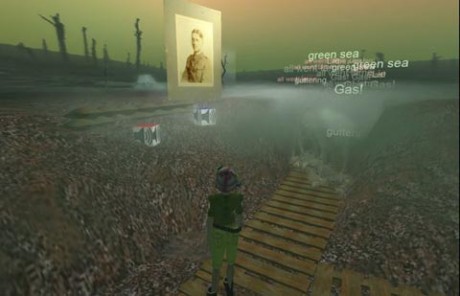
A scene from the University of Oxford’s First World War representation in Second Life. The visitor is able to walk around in the trenches and ultimately climb a ladder up on to the battlefield itself; the cubes with a loudspeaker symbol on them enable playback of audio material such as poetry readings and interviews. The green-tinged cloud and floating text ahead are part of a section on the use of poison gas during the War.
Overall, the Second Life representation is quite an intense and powerful experience, and I can imagine it will be a particularly effective educational tool.
The challenge for an environment like this is that there is a fairly steep learning curve before visitors can fully experience what a virtual world like Second Life can offer – before you can experience an installation like this you have to learn how to move around, activate things and generally operate successfully in the environment. However in this case you really need to be able to do little more than walk around and click on objects, so most people will require no more than a few minutes of training to be able to get the most out of virtual re-creations like this.
I wish the First World War Poetry Digital Archive every success with this project and am very pleased to have been able to make a small contribution to it. This installation will also be featured in the 10 November edition of the Designing Worlds show on Treet.TV.
*“…And each slow dusk a drawing down of blinds.” is the final line of Anthem for Doomed Youth by World War I poet Wilfred Owen – one of the WWI poems I’ve recorded for this project. Photos courtesy of First World War Poetry Digital Archive.
October 26, 2009 Comments Off on “…And each slow dusk a drawing down of blinds.”
Ironbridge Gorge Museums
Ironbridge, near Telford in Shropshire, is rightly regarded as one of the foundations of the Industrial Revolution. Here in 1707, Abraham Darby perfected (and patented) a method of smelting iron ore using coke.
Previously, the process required charcoal, which takes a great deal of time and effort to produce, first growing the trees (!), then burning the wood under the right conditions. As a result, the amount of iron that could be smelted was limited by the supply of charcoal. The discovery of a means of using coke – which is derived from coal – meant that iron could be produced as quickly as the coal could be mined. This enabled the Industrial Revolution to take off.
In 1779 the great Iron Bridge across the Severn, after which the town is named, was built by Abraham Darby III. It was the first cast-iron bridge in the world.
Today, the industry that characterised the area for hundreds of years is largely silent, but in its place is a collection of nearly a dozen different museums and attractions that help us to understand our industrial heritage. You can find out more about them here. In 1986 the Gorge was one of the first seven UK sites awarded World Heritage Site status by UNESCO.

The Museum of the Gorge is housed in a converted Gothic-style riverside warehouse, where goods where stored prior to shipping down the Severn.
To see all the major locations will take you more than a day, particularly as a result of the extensiveness of Blists Hill Victorian Town. However, I suggest you start at the Museum of the Gorge, which boasts one of the most detailed dioramas I’ve ever seen, in this case of the stretch of the Severn and the enormous collection of industrial activities carried out here from mediæval times onwards.
In addition, you might like to take in the Coalbrookdale Museum of Iron. However the most extensive location to visit in the area is Blists Hill Victorian Town. Based around the site of an old brick works, the town consists of buildings either restored, relocated or specially built following detailed research.
You enter the town via a very impressive (and recent) audiovisual presentation which highlights the region’s industrial heritage, and then you’re on the main street, where the first building is a Lloyds Bank. Here you can exchange modern money for traditional pre-1971 £.s.d. that you can use to buy items in the shops on the site (they also take modern money, unlike the Kentwell Hall’s Tudor re-enactments, where beyond the “time tunnel”, all transactions have to be done with the traditional coinage).
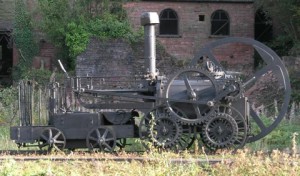
Replica of Richard Trevithick’s locally-built Pen-y-Darren locomotive of 1809
There are working steam engines, including one used to raise and lower a mine cage and a replica of Richard Trevithick’s 1802 Pen-y-Darren locomotive. There are a couple of very impressive beam engines originally used to blow air into blast furnaces, but regrettably these will never steam again and are demonstrated by driving with an electric motor.
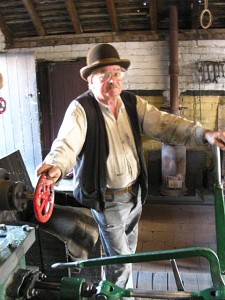
The operator of the mineshaft winding gear steam engine
Costumed staff are on hand to describe the businesses, shops and industry of the Victorian era and I was very tempted to turn up in costume – though I was not sure how they would react. Some places love you to do that, while others (notably Kentwell) abhor it, as you might be mistaken for staff and, not knowing the back-story, might let them down (at Kentwell the back-story is so detailed that this is a real possibility). Beamish, I seem to recall, lets you turn up in costume and they give you a special tag (suitably printed in letterpress fonts of the period, presumably in their print shop) to indicate that you’re a “Visitor”.
Indeed, the obvious comparison with Blists Hill is Beamish, and there is apparently a little rivalry between the two sites, it was hinted, but in fact the two, while there is some obvious overlap, have some significant differences – the money at Blists Hill and the trams at Beamish for example. At Blists Hill, you get around on foot or by horse-drawn wagon.
Blists Hill has a wide selection of shops, sometimes producing and selling items; there are also some performances by a pair of actors who present hilarious excerpts from Shakespeare (with the help of the audience) and there are music-hall songs in the pub from time to time.
I did not take a great deal of video, but here is one extract. Down the bottom of the town there’s a Victorian funfair, including a merry-go-round, which originally, one presumes, would have been driven by a steam traction engine. There’s a nice little Pell organ on this one, playing various medleys of tunes of the era, of which you can hear a sample below.
October 1, 2009 Comments Off on Ironbridge Gorge Museums
Tour of a Victorian Bobbin Mill
This video takes you on a tour of a Victorian bobbin mill at Stott Park, near Lake Windermere, in the Lake District, Cumbria.
Tour of a Victorian Bobbin Mill, Stott Park, Cumbria from Richard Elen on Vimeo.

Enormous cogwheels at Stott Park bobbin mill
Stott Park Bobbin Mill was opened in 1835 to supply the cotton mills of Lancashire (of which this area was a part at the time) with bobbins to carry the thread which was spun into cloth. It was originally powered by a water wheel, later by a water turbine and then by a steam engine. Ultimately, electricity arrived. The mill finally closed in 1971 and then reopened in 1983 as a museum.

Exterior view of the building showing the end of the line shaft and a belt drive
Today, Stott Park Bobbin Mill is in the care of English Heritage, and in this video you’ll be taken on a 20-minute guided tour of the mill by one of the English Heritage staff members to see the different stages of the bobbin-making process, including some of the machines being used by a veteran mill worker.
You’ll see the steam engine, although it was not, regrettably, in steam on this occasion, and get a feeling for what life was like for the mill workers – who, in this case, came mainly from the workhouses of Liverpool and Manchester.

View through the window in the previous picture into part of the building showing some of the machines and the belts leading up to the overhead line shaft
For many years, the manager of this mill was a woman, and curiously she only had male workers in the mill; generally mills of this type were operated by women, who were widely believed to be better at the job.
I am grateful to the staff at Stott Park and to English Heritage for providing the tour depicted in this video.
This video is part of an ongoing series intended to give an insight into Britain’s early industrial technology.
September 28, 2009 Comments Off on Tour of a Victorian Bobbin Mill
Renaissance Music at Lincoln Castle
I was in Lincoln recently for the glorious Weekend at the Asylum Steampunk Convivial (you can find a selection of my pictures of that event here). Wandering around the centre of Lincoln as the event wound down on the Sunday afternoon, I stumbled across this group of musicians playing live in the heart of the old castle.
This video is very impromptu and hand-held – essentially little more than a stringing together of a few different shots – but you can experience the atmosphere of the performance (albeit with a touch of wind-noise from time to time).
Kudos to the City of Lincoln Waites for their excellent playing and for the fact that they persevered despite it being quite cool and breezy.
Instruments played include a variety of percussion instruments; the sackbut (predecessor to the trombone); various recorders; a rackett (the compact reed instrument played occasionally by one of the performers seated on the step); a shawm or two (predecessor of the oboe); and a sopranino rauschpfeife shown below (played in some pieces by the woman on the right in the video), which has no modern equivalent. It’s a capped reed instrument (like a bagpipe chanter: your lips do not touch the reed as in modern woodwinds) with a conical bore; it’s a relative of the crumhorn but a good deal louder and more difficult to play (as it easily overblows).
Apart from the recorders this would probably have been described as a “loud band”, playing the kind of instruments you would expect to hear outdoors at public events.
Postscript
I heard today (6 October) from Al Garrod, the Master of the City of Lincoln Waites – the name of the band playing in this video. Al is the sackbut player. Do please visit their site and if you get the chance to hear them, I recommend them highly.
September 23, 2009 Comments Off on Renaissance Music at Lincoln Castle
A Visit to Beamish
The other weekend I had the great opportunity to visit the Beamish open-air museum in County Durham. I was staying with friends near Sunderland for the weekend and their suggestion that we went there was a very good one. I can heartily recommend the museum to anyone interested in our industrial history – and particularly that of Northern England.
Not only that, the Museum is currently offering a special deal where for £16 you get a year’s admission. Well, it’s worth that for just one visit – you need to allocate an entire day to the site (and still you won’t get round it all).
Both my friends have been involved with Beamish over the years and as a result they knew all the cool places to go. There are quite a few buildings and other items on-site, each having been painstakingly dismantled, brought to the site, and rebuilt.
The centrepiece, I suppose, is a rebuilt town street, set in 1913, with a terrace of houses (including an early 20th century dentist, a pianoforte teacher’s house and much more) and shops including a Co-Op, a sweet shop with sweeties made on the premises, a garage, a bank, and the most recent addition, a Masonic Hall with a comprehensive display of artefacts and regalia. There’s also an excellent cafeteria!
There’s also a Waggonway, set in 1825, where you can travel for a few hundred yards behind a replica early steam locomotive (see below); a Colliery Village circa 1913 and an old Manor on the hill. The different areas are linked by period buses and trams.
The period covered is broadly Victorian/Edwardian, but some locations (such as the Waggonway and the Manor, which are set in 1825) are set in earlier periods. Everywhere there are staff members (in costume) who will tell you about the old practices and explain what you’re seeing. I really couldn’t fault them.
This is a really tremendous place to visit and I can’t recommend it enough – I’ll be back as soon as I can.
I took some video while I was there and present them below. All three items are hand-held so I’m afraid they are a little wobbly at times, but hopefully they will give you a feel for some aspects of the place.
This first one is of the Pockerley Waggonway, where we travelled for a short distance behind the “Steam Elephant”, an early steam locomotive. We see the journey from an open coach and also from the track-side, and the trip is preceded by some background from a staff member.
Pockerley Waggonway at Beamish Museum from Richard Elen on Vimeo.
The second item is also from the Waggonway area: it’s a demonstration of a traditional Pole Lathe, used by a “bodger” to make things like table and chair legs and other items that could be turned from wood. The operator, William Slassor, describes its principles, operation, and how it was used.
Pole Lathe at Beamish Museum from Richard Elen on Vimeo.
And finally, a short video of a gentleman playing a German ‘Harmonipan’ street organ in the main street of the reconstructed town.
The instrument is hand-cranked, and turning the handle both operates the bellows that enable the pipes to sound; it also draws a roll of punched paper tape about 2in wide across a what we might call a “reader”, consisting of a row of holes, each connected to a pipe. The bellows pass air to the reader, and where there is a hole in the tape, air passes through and off to the corresponding pipe.
The music is a medley of American tunes, and ends with quite a flourish. I wasn’t able to capture the very beginning of the medley, but I got most of it and what there is effectively captures the feeling of this kind of street entertainment, common in the Victorian and Edwardian eras.
‘Harmonipan’ Street Organ at Beamish Museum from Richard Elen on Vimeo.
September 2, 2009 Comments Off on A Visit to Beamish

